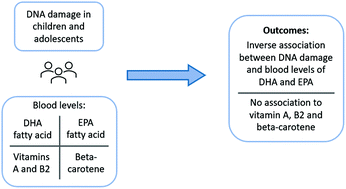This study aimed to investigate the association between DNA damage and blood levels of docosahexaenoic acid (DHA), eicosapentaenoic acid (EPA), retinol, beta-carotene and riboflavin in Brazilian children and adolescents. Subjects (n = 140) were healthy boys and girls aged 9 to 13 years in Ribeirão Preto (SP, Brazil). Data collection included anthropometry, assessment of energy intake and blood sampling. DNA damage was evaluated by single-cell gel electrophoresis (comet assay). Principal component analysis (PCA) was used to verify associations between blood concentrations of vitamins, polyunsaturated fatty acids and DNA damage. Multiple regression analyses, k-means cluster, and analysis of covariance (ANCOVA), adjusted for confounding variables such as age, sex, energy intake, body mass index and total cholesterol (when needed), were applied to confirm the associations. PCA explained 69.4% of the inverse relationships between DNA damage and blood levels of DHA, EPA, retinol, and beta-carotene. Results were confirmed by ANCOVA and multiple regression analyses for DHA and EPA. In conclusion, omega-3-fatty acids were inversely associated with DNA damage in Brazilian children and adolescents and may be a protective factor against the development of future diseases.

